World Geography And Politics Daily News | 19 May 2023

Views (214)
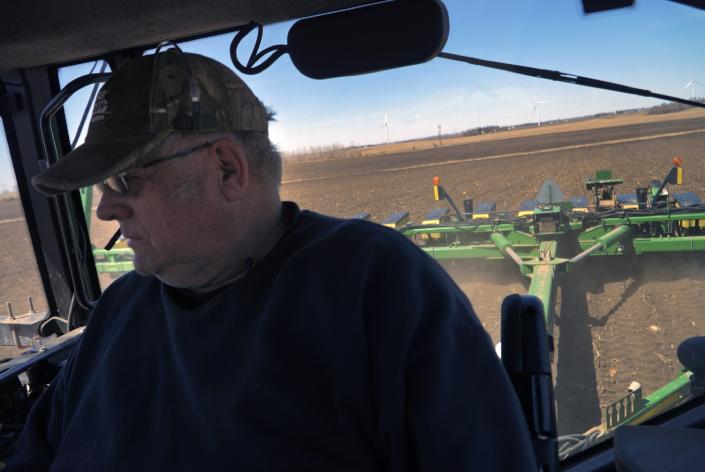
Syria's Assad arrives in Saudi Arabia for regional summit, sealing his return to the Arab fold
Syrian President Bashar Assad arrived on Thursday in Saudi Arabia to attend a regional summit that is expected to seal Syria's return to the Arab fold, marking his first visit to the oil-rich kingdom since Syria’s conflict began in 2011. Assad's attendance at the Arab League summit, which starts Friday, is a major step in normalizing relations following a 12-year suspension which saw the embattled leader turn toward non-Arab allies Iran and Russia to maintain his grip on power. The 22-member league, which is convening in the Saudi city of Jeddah, recently reinstated Syria and is now poised to welcome Assad, once viewed as a regional pariah, back into its ranks.

JEDDAH, Saudi Arabia (AP) — Syrian President Bashar Assad arrived on Thursday in Saudi Arabia to attend a regional summit that is expected to seal Syria's return to the Arab fold, marking his first visit to the oil-rich kingdom since Syria’s conflict began in 2011.
Assad's attendance at the Arab League summit, which starts Friday, is a major step in normalizing relations following a 12-year suspension which saw the embattled leader turn toward non-Arab allies Iran and Russia to maintain his grip on power.
The 22-member league, which is convening in the Saudi city of Jeddah, recently reinstated Syria and is now poised to welcome Assad, once viewed as a regional pariah, back into its ranks. The Syrian president was officially invited to attend the summit last week.
Assad appeared relaxed and cheerful as he descended onto the tarmac, where he was greeted by Prince Badr bin Sultan, deputy governor of the shrine city Mecca, along with Arab League Secretary-General Ahmed Aboul Gheit and several local officials.
It was not immediately clear if Assad will meet some of the Arab leaders attending Friday's summit. During Syria's conflict, Assad only visited Russia and Iran and over the past two years he went to Oman and the United Arab Emirates.
Saudi Arabia was formerly key backer of armed opposition groups attempting to overthrow Assad. However, in recent months, Riyadh has called for dialogue to end the conflict that has killed half a million people and displaced half of Syria’s pre-war population.
Assad’s troops have taken control of much of Syria thanks to the support of Russia and Iran that helped tip the war in his favor.
Relations between Syria and Saudi Arabia had been turbulent since Assad took office in 2000, following the death of his late father and former president, Hafaz Assad. The two countries cut relations in 2012, at the height of Syria’s conflict. Last week they agreed on reopening their embassies.
In April, Syrian Foreign Minister Faisal Mekdad visited Riyadh and his Saudi counterpart, Prince Faisal bin Farhan, visited Damascus and met with Assad. Mekdad also took part in Arab foreign ministers meeting in Jeddah on Wednesday ahead of the summit.
Saudi Crown Prince Mohammed bin Salman has been pushing for peace in the region and over the past months, Riyadh has improved its relations with Iran, restored ties with Syria and is ending the kingdom’s yearslong war in Yemen. Iran, a main backer of the Syrian government in the country's conflict, signed an agreement in China in March to resume relations with Saudi Arabia.
The renewed Saudi-Iran ties are expected to have positive effects on Middle East countries where the two support rival groups.
However, investments in war-torn Syria are unlikely as crippling Western sanctions against Assad’s government remain in place and could prevent oil-rich Arab countries from rushing to release reconstruction funds.
Washington has been strongly opposed to normalization of relations with Assad, saying a solution to Syria’s conflict based on U.N. Security Council resolutions should happen first.
Diplomatic contacts intensified between Damascus and Arab countries following the Feb. 6, earthquake that hit Turkey and Syria killing more than 50,000 people, including over 6,000 in Syria.
In addition to Saudi Arabia, Jordan and Egypt have also renewed ties with Damascus, following normalization efforts from the United Arab Emirates and Bahrain years ago.
Still, Kuwait, Morocco, and Qatar, remain opposed to normalizing relations with Syria and Qatar continues to be a key backer of Syrian rebel groups fighting Assad.
___
Associated Press writer Albert Aji in Damascus, Syria, contributed to this report.
Deutsche Bank to pay $75 million to settle lawsuit from Epstein victims, lawyers say
Deutsche Bank has agreed to pay $75 million to settle a lawsuit claiming that the German lender should have seen evidence of sex trafficking by Jeffrey Epstein when he was a client, according to lawyers for women who say they were abused by the late financier. A woman only identified as Jane Doe sued the bank in federal district court in New York and sought class-action status to represent other victims of Epstein. The lawsuit asserted that the bank knowingly benefited from Epstein’s sex trafficking and “chose profit over following the law” to earn millions of dollars from the businessman.
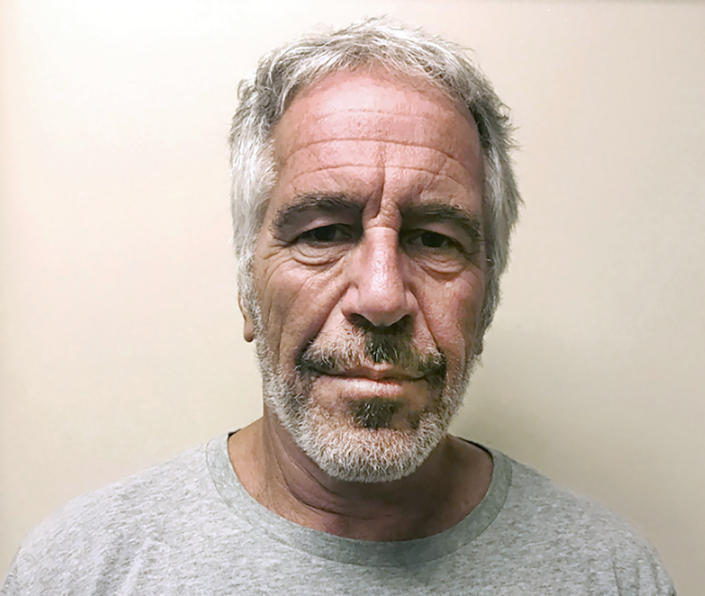
A woman only identified as Jane Doe sued the bank in federal district court in New York and sought class-action status to represent other victims of Epstein. The lawsuit asserted that the bank knowingly benefited from Epstein’s sex trafficking and “chose profit over following the law” to earn millions of dollars from the businessman.
One of the law firms representing women in the case, Edwards Pottinger, said it believed it is the largest sex trafficking settlement with a bank in U.S. history.
“The settlement will allow dozens of survivors of Jeffrey Epstein to finally attempt to restore their faith in our system knowing that all individuals and entities who facilitated Epstein’s sex-trafficking operation will finally be held accountable,” the firm said in statement.
Deutsche Bank would not comment on the settlement Thursday but noted a 2020 statement from the bank acknowledging its mistake in taking on Epstein as a client, said Frank Hartmann, the German lender’s global head of media relations.
“The Bank has invested more than 4 billion euros ($4.3 billion) to bolster controls, processes and training, and hired more people to fight financial crime,” Hartmann said in a written statement.
The Boies Schiller Flexner law firm, which also represents plaintiffs, called the settlement an important step for victims' rights.
“The scope and scale of Epstein’s abuse, and the many years it continued in plain sight, could not have happened without the collaboration and support of many powerful individuals and institutions,” David Boies, the firm's chairman, said in a statement.
The German lender said late last year that it provided “routine banking services” to Epstein from 2013 to 2018 and that the lawsuit “does not come close to adequately alleging that Deutsche Bank ... was part of Epstein’s criminal sex trafficking ring.”
A U.S. judge decided last month that JPMorgan Chase CEO Jamie Dimon must face up to two days of questioning by lawyers handling the lawsuits.
Feinstein's office details previously unknown complications from shingles illness
Democratic Sen. Dianne Feinstein’s office said Thursday that she is suffering from Ramsay Hunt syndrome, a complication from the shingles virus that can paralyze part of the face, and that she contracted encephalitis while recovering from the virus earlier this year. Feinstein, 89, had not previously disclosed those medical details, though she said in a statement last week that she had suffered complications from the virus. The longtime California senator returned from a more than two-month absence on May 10 after weeks of questions about her declining health and whether she would be back in the Senate at all.
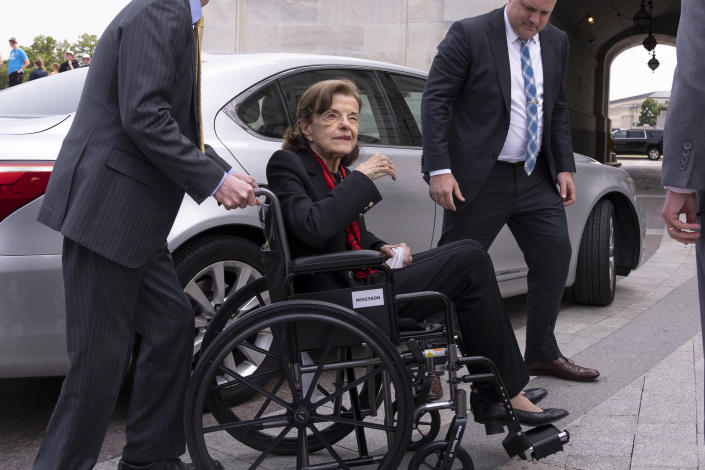
WASHINGTON (AP) — Democratic Sen. Dianne Feinstein’s office said Thursday that she is suffering from Ramsay Hunt syndrome, a complication from the shingles virus that can paralyze part of the face, and that she contracted encephalitis while recovering from the virus earlier this year.
Adam Russell, a spokesman for Feinstein, said that the encephalitis, or inflammation of the brain, “resolved itself shortly after she was released from the hospital in March.” Feinstein continues to have complications from the Ramsay Hunt syndrome, Russell said.
Russell confirmed the two complications after the New York Times first reported them, raising questions about whether she had been hiding the extent of her illnesses. Upon her return last week, Feinstein was using a wheelchair and noticeably thinner, and has appeared confused at times when speaking to reporters or being wheeled through the halls.
“The senator previously disclosed that she had several complications related to her shingles diagnosis,” Russell said in the statement. “As discussed in the New York Times article, those complications included Ramsay Hunt syndrome and encephalitis.”
Feinstein’s face has appeared partially paralyzed since she returned to the Senate, stirring some speculation about whether she had had a stroke. Ramsay Hunt syndrome is a complication that occurs when the shingles virus reaches a facial nerve near the ears. It can also cause hearing loss.
Encephalitis can also be caused by shingles. The swelling of the brain can have a number of different symptoms, including personality changes, seizures, stiffness, confusion and problems with sight or hearing, according to the Mayo Clinic.
Aides to Feinstein said last week that she is still recovering from her illness and would operate on a reduced schedule. Since she has returned, she has missed some votes where she was not needed. On Wednesday, for example, she missed the first three Senate votes of the day but appeared for the last two, in which the margin was much closer.
Feinstein has faced questions for several years about her clearly declining health and her mental acuity. In February Feinstein said she would not run for re-election in 2024.
Two weeks later, Democrats said that Feinstein would return to Washington.
A senator for more than three decades, Feinstein has had a groundbreaking political career and shattered gender barriers. She was the first woman to serve as president of the San Francisco Board of Supervisors in the 1970s and the first female mayor of San Francisco. She ascended to that post after the November 1978 assassinations of then-Mayor George Moscone and City Supervisor Harvey Milk by a former supervisor, Dan White. Feinstein found Milk’s body.
In the Senate, she was the first woman to head the Senate Intelligence Committee and the first woman to serve as the Judiciary Committee’s top Democrat.
False claims of a stolen election thrive unchecked on Twitter even as Musk promises otherwise
In an interview this week, Twitter owner Elon Musk said users making false claims of stolen elections “will be corrected” on the platform. Prompted by a CNBC reporter for extra assurance that would happen, Musk responded, “Oh yeah, 100%.” Twitter posts that amplified those false claims have thousands of shares with no visible enforcement, a review of posts on the platform shows.
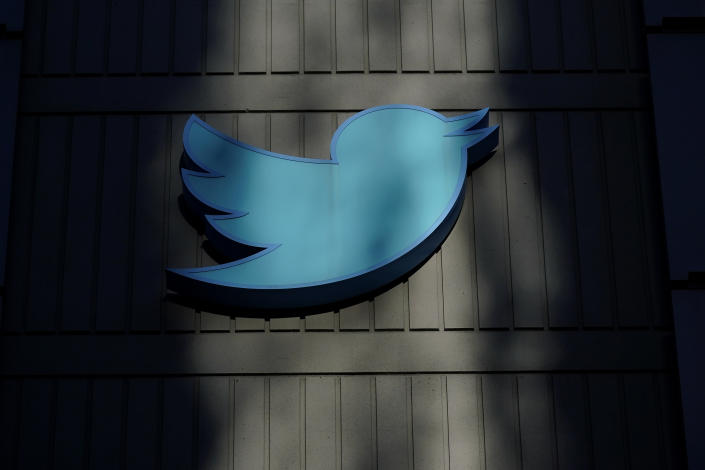
Prompted by a CNBC reporter for extra assurance that would happen, Musk responded, “Oh yeah, 100%.”
The contrast between Musk’s promise and the extent the claims are spreading on Twitter underscores a major challenge for social media companies trying to call out election conspiracy theories and falsehoods that Trump and his supporters continue to promote. That will only grow as the nation prepares for a presidential election next year in which Trump is again vying to be the Republican nominee.
“Talk is cheap,” said David Becker, a former U.S. Justice Department lawyer who now leads the nonprofit Center for Election Innovation and Research. “It’s good that he acknowledges that it’s important for Twitter to act responsibly. … But then we have to see this action actually taken, because it’s happening right now.”
An analysis by the media intelligence firm Zignal Labs on behalf of The Associated Press surfaced the 10 most widely shared tweets promoting a “rigged election” narrative in the five days following Trump’s town hall.
While Twitter has a system in place for users to add context to misleading tweets, the 10 posts, which collectively amassed more than 43,000 retweets, had no such notes attached.
The most widely shared tweets included false claims from U.S. Rep. Marjorie Taylor Greene, R-Ga., and Kari Lake, a Republican who lost her bid for Arizona governor last year.
In January 2022, months before Musk took over the platform that October, Twitter had already confirmed to CNN that it had stopped taking action against 2020 election misinformation, saying its policy was meant for use during an election cycle, not long after one.
Tech accountability advocates said it's difficult to monitor content on a scale as large as Twitter and they note that Twitter is not the only platform where election misinformation surfaces. TikTok, Facebook, Instagram and other social media sites also play a role in spreading falsehoods.
“I think they already had inadequate resources … but there’s no doubt that he’s making it worse,” Lehrich said. “And he’s effectively fired everyone responsible for trust and safety at Twitter, so at this point, they couldn’t enforce their own civic integrity policies if they tried.”
Twitter sent an automated reply when the AP asked for comment, as Twitter does to most media inquiries, and did not provide a response to the continued spread of election misinformation.
In an ideal world, platforms would help reduce the spread of false claims online with policies such as blocking known misinformation sources, labeling it, adopting community enforcement standards and deprioritizing misinformation in trending topics, said Anjana Susarla, a social media researcher and professor at Michigan State University.
Complicating Twitter's response to the misinformation is Musk's own use of the platform. He has used his Twitter account to amplify election-related conspiracy theories.
Last week, he tweeted a reply to a false claim that a conference hosted by the Center for Election Innovation and Research was “secret” and “HYPER PARTISAN.”
Musk's post drove other Twitter users to see the original tweet and pile on with stolen-election claims.
“He gets it … he knows the elections were stolen massively,” one Twitter user replied.
“Exactly. They’re coordinating the steal for 2024,” wrote another.
Becker, the center’s executive director, said when prominent Twitter users amplify falsehoods about election officials, “threats increase to their safety, to their offices, to their staff.”
“That makes democracy more vulnerable and puts stresses on them as human beings,” he said.
____
___
Videos show gunman saying 'kill me' to onrushing officers in New Mexico rampage that killed 3
Videos released Thursday of this week’s deadly rampage in northwest New Mexico recorded a voice said to be the shooter urging police to “kill me” and officers rushing toward the 18-year-old gunman before fatally shooting him outside a church. “He is yelling on the Ring footage, ‘Come kill me,'" Farmington Police Chief Steve Hebbe said of Beau Wilson, the high school senior who authorities say killed three older women during the attack. “He’s making a stand, he has opportunities to run off, he does not use those opportunities,” Hebbe said.
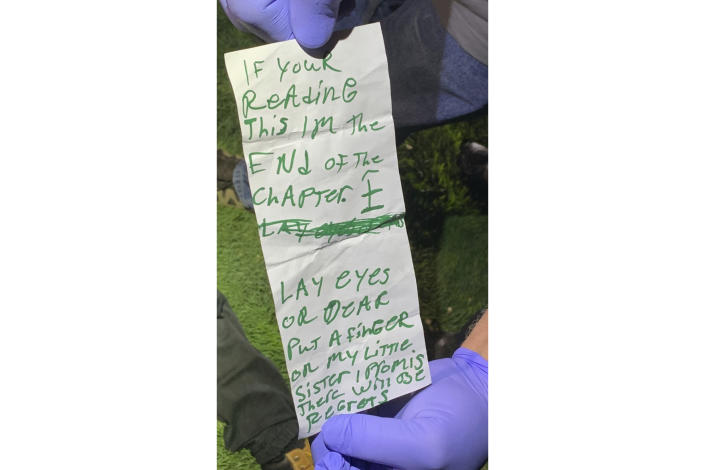
SANTA FE, N.M. (AP) — Videos released Thursday of this week’s deadly rampage in northwest New Mexico recorded a voice said to be the shooter urging police to “kill me” and officers rushing toward the 18-year-old gunman before fatally shooting him outside a church.
“He is yelling on the Ring footage, ‘Come kill me,'" Farmington Police Chief Steve Hebbe said of Beau Wilson, the high school senior who authorities say killed three older women during the attack.
“He’s making a stand, he has opportunities to run off, he does not use those opportunities,” Hebbe said. "So yes it’s my belief that ultimately in his head, he has made the decision that he is going to stand and fight it out until he is killed.”
Three older woman were killed Monday by the shooter, including a mother and daughter who happened to be driving through the neighborhood. The victims were identified as longtime Farmington residents Gwendolyn Schofield, 97, her 73-year-old daughter, Melody Ivie, and 79-year-old Shirley Voita.
At least six other people were wounded in the shootings, which sent waves of grief rippling through the community of 50,000 people. They included two police officers, who have been released from medical care as they recover.
Hebbe's comments mirrored an account from witness Candi Brammell, who lives next to the church and told The Associated Press in an interview Tuesday that the gunman seemed to be egging police on, saying: “Come on!”
Brammell said she couldn’t believe what she was seeing as Wilson opened fire. Within an instant, he was exchanging shots with the police and then was down in the grass.
Wilson lived with his father in a home that contained an arsenal of weapons and ammunition, apparently legally owned, according to law enforcement authorities. He bought an assault-style rifle last year after he turned 18.
On Monday, police say, he began shooting indiscriminately with the rifle from the front porch area of the home.
The first person hit was Voita, a retired nurse who was driving by. Video released by police showed her car rolling down the street with the door open after she managed to get out. Video also showed the path of a vehicle carrying Schofield and Ivie, who stopped to help.
“They see something in the road, which turns out to be (Voita), and they’re in the process of pulling over” when another hail of gunfire erupts, Hebbe said, narrating the images. “At that time we believe all those rounds are fired from (the rifle).”
Police say Wilson soon dropped the weapon into some bushes even though it still held more live ammunition.
Wilson then walked down the street for about a quarter mile, spraying bullets indiscriminately using two pistols. He discharged a .22-caliber gun and then depleted rounds from a 9-mm weapon in the final shootout with police, during which he let off at least 18 rounds.
He wore what appeared to be a modified protective vest with steel plates, but authorities say he discarded the vest before the shootout with police.
Police body camera video showed the perspective of one officer walking and running down the middle of the residential street, readying an assault rifle in one hand while barking commands into a radio in the other. On the run, he takes cues from a local resident and a dog runs beside them.
That video is later partially obscured, but a shadow on the ground shows the officer bracing in firing position for the final confrontation.
“I have eyes on the suspect. He’s walking south. He’s wearing all black,” an officer tells dispatchers in another video segment.
He then yells, “Farmington police! Let’s see your hands!“
A police car speeds by with flashing lights and sirens.
Video from the body camera of Sgt. Rachel Discenza showed her pointing her handgun toward where the suspect was standing. Amid an exchange of gunfire, she falls to the ground, and says: “I’m shot.“
She struggles unsuccessfully to get up, and a fellow officer uses her belt as a tourniquet.
“We got one hit. Get me a medic here for sarge,“ he yells.
In the grass in front of the church, officers rush to the suspect after the gunfire subsides, telling him not to move. One officer cuffs him, while another says, “Subject is down. He is secured."
A note was later found in the pocket of the discarded vest that said, “If your reading this im the end of the chapter.
The gunman’s body was left in the grass for a time as investigators worked the scene, and it was unclear then how many times he was shot.
Police said earlier this week that they couldn't say how many gunshot wounds the victims had suffered and were waiting on the medical investigator's report, which had not been made public as of Thursday.
Neighbor Bryan Brown, who was among those who ran to render first aid, told AP that Voita had gunshot wounds to the leg and the head.
Police have been probing for motivations behind Monday’s rampage, which took place the day before Wilson was due to graduate from high school, amid some indications from relatives of prior mental health issues.
Efforts were underway by authorities to access medical and school records that might shed light on his mental history.
___
Montoya Bryan reported from Albuquerque and Snow reported from Phoenix.
Saving the farm: Heartland clergy train to prevent agriculture workers’ suicides
With traces of winter’s unusually heavy snow still lingering but a warm sun finally shining, farmers were out dawn to dusk in early May on their tractors, planting corn and soybeans across southwestern Minnesota fields many have owned for generations. The threat of losing these beloved family farms has become a constant worry, affecting many farmers’ mental health and raising concerns of another uptick in suicides like during the 1980s farm crisis.
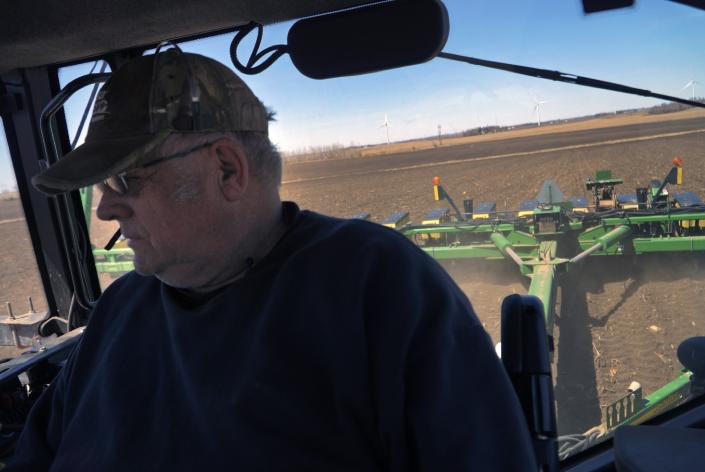
LAKE BENTON, Minn. (AP) — With traces of winter’s unusually heavy snow still lingering but a warm sun finally shining, farmers were out dawn to dusk in early May on their tractors, planting corn and soybeans across southwestern Minnesota fields many have owned for generations.
The threat of losing these beloved family farms has become a constant worry, affecting many farmers’ mental health and raising concerns of another uptick in suicides like during the 1980s farm crisis. Much of the stress stems from being dependent on factors largely outside their control – from the increasingly unpredictable weather to growing costs of equipment to global market swings that can wipe out profits.
“You’d be surprised how many people are suffering with depression. Farmers have been a group of people who keep problems to themselves, proud and private,” said Bob Worth, a third-generation crop farmer who with his son works 2,100 acres of rich, black soil near the hamlet of Lake Benton.
“The more you talk about this, the more you realize it can be fixed,” added Worth, who credits his wife with saving his life in the 1980s when he got so depressed that he wouldn’t budge from bed even for the harvest. At least three neighbors and fellow farmers killed themselves, Worth said.
Increasingly aware of agricultural workers’ struggles with mental health, states such as Minnesota and South Dakota, a few miles west of Worth’s farm, are offering suicide prevention training to clergy – who are a crucial, trusted presence in rural America.
In Pipestone, the bigger town down the dirt road from Worth’s farm – with 4,200 residents and a dozen churches – pastors from three Lutheran parishes are taking the four-week suicide prevention program for clergy that Minnesota’s departments of agriculture and health launched this spring.
“I want to learn to help. This could be anybody,” said the Rev. Robert Moeller, recalling his first realization of the scourge of suicide among farmers, when a customer in the feed business he worked at before being ordained killed himself.
Moeller plans to introduce suicide prevention in his 5th through 8th grade catechism class at Our Saviour’s Lutheran Church, and is eager to learn about supporting surviving family members and those who attempted suicide without the stigma and shame often attached to it.
___
EDITOR’S NOTE — This story includes discussion of suicide. The national suicide and crisis lifeline is available by calling or texting 988. There is also an online chat at 988lifeline.org.
___
“Every farm family I know has a relationship with a house of worship,” said Meg Moynihan, a dairy farmer in southern Minnesota who’s been developing the clergy-focused training programs as a senior advisor to the state's agriculture department. “There’s a huge sense of pride."
The evident satisfaction that farmers take in growing crops and raising livestock to feed the country – and beyond, as corn for example is also often sold to China – makes the fear of being unable to keep going a key factor in mental health distress.
“It’s not losing a job or a place. There’s a sense of threat to one’s identity and generational legacy across time,” said Sean Brotherson, professor and extension family science specialist at North Dakota State University. “People treat the farm as a member of the family – and the longest-living member of the family.”
The question, he said, becomes who is going to be the one to decide it's time to let the farm go.
With financing tapped out and feeling they might not be able to pay off more equity in their middle age, Keith and Theresia Gillie started talking about finding jobs away from his homestead in northwestern Minnesota.
“I never realized that in the midst of us quitting farming, that was his identity,” said Gillie, who found her husband of more than 30 years dead on a gravel road. Six years later, she’s still farming wheat, soybean and sunflowers with two neighbors’ help, and has spoken out about Keith’s suicide to get more farmers to open up about their struggles.
Male agricultural workers’ suicide rates are more than two times higher than the national average, according to the Centers for Disease Control and Prevention. There are several issues that play a role, including increased isolation and exacerbated family tensions during the pandemic, the difficulty in rural communities to find in-person mental health counseling or to access broadband for tele-health, as well as the disruptions brought by climate change-driven unpredictable weather patterns, inflation and international trade disputes.
As the average age for farmers inches toward 60, the pressure of passing on a life-defining legacy to new generations is a growing problem, said Monica McConkey, a rural mental health specialist contracted by Minnesota’s agriculture department to provide counseling at no cost.
Driving his tractor and planter, some $750,000 in machinery, Todd Sanderson reflected on how farming has changed in the 42 seasons he’s been planting corn outside Flandreau, South Dakota. An eye to the sky is still foremost – Sanderson decided to get the seeds in the ground the first week of May even though frost still covered the tractor’s windshield in the morning, because later planting means meager yields.
The physical demands have diminished, with technology in his tractor resembling a cockpit more than an agrarian tool, but the uncertainty of making enough to keep the land only grows as the capital investments rise. Sanderson, 61, hopes a nephew will take over from him eventually.
“That’s what’s keeping me up at night, the transition,” he said. “We out here in ag are pretty solitary. If your mind is going in the wrong direction, it’s pretty easy to end up in a bad place. The more I get stressed, the more I get quiet.”
Breaking farmers out of that proud reserve is a big challenge, even for clergy, said the Rev. Alan Blankenfeld. He is the rural ministry liaison for the Evangelical Lutheran Church in America's South Dakota synod and Sanderson’s former pastor in Flandreau, where they started a suicide prevention program that includes Spanish information, since many dairy workers there are immigrants.
“As a pastor, you don’t always have to have something profound to say. It’s just, show up,” said Blankenfeld, who likes to visit farmers and ranchers so they don’t have to come to a church, where their parked vehicle might be recognized by everyone in town and start a rumor mill. “They’ll share on their terms. Our place is not counseling, but we can walk with them.”
Back across the state line in Pipestone, the Rev. Ann Zastrow of First Lutheran Church, who’s taking the Minnesota online prevention course, hopes to build up her confidence to remind those struggling with mental health that “God is still in the picture.”
In many farm families, faith and struggle have long coexisted. First Lutheran’s council president, a retired hog farmer who now raises lambs from 500 ewes outside town, said he still remembers when his mother asked him to take guns out of the house because she was worried about his father.
“Stress and depression and suicide in a farmer is part of it. You just hope that it isn't your part,” Craig Thies said as newborn lambs tottered around him. “I remember the look on (my father’s) face when they sold his cows. Realistically, they’re like your children. But somebody is eating tonight because of you.”
Seeing themselves as part of a crucial creation plan cements farmers’ faith and involvement in church activities, which have historically forged bonds in otherwise isolated homesteads.
That in turn makes the clergy potential lifesavers when given the right tools to help with compassion and without the moral judgment that many still fear about suicide.
“One place we struggle within the church is if we treat suicide as shameful, then they won’t share they’re not okay,” said the Rev. Kelly Ahola, a Lutheran pastor in the Red River Valley, where springtime flooding can wreak havoc on farmland in Minnesota and North Dakota. “We need to say the words. We need to learn to ask, are you thinking of suicide? We need to train the congregation too to know when and how to intervene.”
How to tackle suicide from the pulpit and how to approach it theologically when many consider it a sin was one of the first questions raised in the four-week training course that Minnesota is running. Most of the 80 clergy from across the state who enrolled in it had encountered suicides in their ministry.
For one of them, the Rev. Jillene Gallatin, the call to prevention is excruciatingly personal. It was her pastor who drove her to the hospital when, at 15, she tried to kill herself a year after her mother took her own life. And it was in her church that she met comfort instead of the deafening silence and averted eyes elsewhere in her community.
“People need to tell their stories and struggles that are not so visible. That’s a gift we can bring as church, being a safe spot,” Gallatin said in the sanctuary of Grace Lutheran Church in Waseca, about an hour south of Minneapolis.
Later that spring day, she visited the dairy farm of a church member. Two brothers, along with their wives, children, and father, run the farm that their German immigrant ancestors founded in the 1870s.
There wasn’t a dry eye in the room when the relatives discussed the option of stopping the milking operation, Jason Eldeen recalled.
But they persevered, which makes them among the 1.3% of U.S. workers with direct on-farm employment, according to a podcast he likes to listen to when out in the fields – and to the U.S. Department of Agriculture’s 2023 data.
“How lucky we are that we get to farm,” he said, as some of the cows reached out to lick his and Gallatin’s hands in the spring sunshine.
—-
0 Likes
